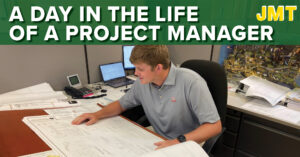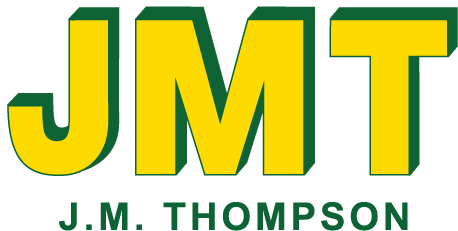What does it take to be a Project Manager?
In the construction industry, it takes the collaboration of an entire project team to see a project from pre-construction to completion. Each team member, from the project manager and superintendent to the subcontractors on site, everyone plays a crucial role in making the owner’s vision into a reality. Have you ever been curious about what a project manager contributes to the team? Seeing a snapshot of their typical day is the best way to understanding what the job requires.
A Day in the Life at Pleasant Park
As a project manager, no day is truly typical, the only constant in the day-to-day tasks is solving problems before they even happen. To the untrained eye, this would seem an impossible feat, but to Tanner Hudson, Assistant Project Manager at J.M. Thompson, this has become the standard operating procedure at his job.
“I try to preemptively deal with problems before they even arise. Sometimes you don’t know what’s coming on the job. I’m still building that sixth sense to see these things before they come,” Tanner stated.
The way you build that sixth sense is through meticulously reviewing the plans and specifications down to their most minute detail and building a strong relationship with your site superintendent. Tanner does this by balancing his time in the office with time out on the jobsite with his superintendent. The project he is currently working on is Pleasant Park, a new 92-acre park for the Town of Apex which will include four tennis courts, six pickleball courts, two basketball courts, six artificial turf fields, and multiple playgrounds that will include a splash pad and inclusive play for children of all ages. “About 40% of my job is spent out in the field which comes down to two days a week. When I’m out here, I’m providing my superintendent support, it’s always a good idea to get another set of eyes on the project site and comparing it to the plans.” Tanner said.
The other 60% of his role is comprised of project paperwork. From subcontracts to pay applications, Tanner plays a part in keeping up with project documentation. Some of the paperwork falls under knowing the plans and specifications inside and out. Understanding these documents allows Tanner to compare what is being constructed on-site meets the desired outcome, schedule subcontractors appropriately on the jobsite, and maintain a healthy flow of submittals for upcoming phases.
When Tanner spots a potential challenge, it can initiate a lot of documentation in order to figure out the best solution. If questions arise from the plans or specifications, then an RFI must be submitted to the architect or project engineer in order to gain clarification. Along with this, submittals must be put together and processed so that the owner and the architect can approve the materials being used on the project. Tanner compiles all of this documentation and manages it through JMT’s construction project management software Procore. This allows all project documentation to be easily accessed by all the stakeholders involved in the project.
Much of what a project manager does relies heavily on communication with all parties involved. This includes communicating with the owner, architect, and project engineers as well as coordinating with the subcontractors. Yet one of the most critical avenues for open communication is between the project manager and the site superintendent. “Cade, my superintendent, keeps me up to speed on what is going on at the jobsite. Cade handles things “in the moment”, while I am trying to stay preemptive. The look ahead schedule is my end of things, while Cade handles the day to day.” Their team dynamic, built on honesty and trust, helps them catch potential challenges early on and implement solutions faster. If Cade witnesses things on the jobsite that garner a question to the architect, he relays that information to Tanner and Tanner begins to craft an RFI. Their flow of communication on the project allows more time to be devoted to pushing the project forward.
Being a project manager is a mix of two worlds: the two-dimensional side with plans and project documentation and the three-dimensional of the physical project being constructed. Tanner reflected, “I enjoy the exposure to both sides, the plans and the tangible project.” In this role, a project manager can bridge the gap between these two worlds in order to construct a successful project.
About J.M. Thompson
A family-owned and operated company, J.M. Thompson brings together vast construction knowledge to each project they take on. The team is comprised of experienced professionals in the industry, as the company is only as good as its employees. The staff assumes full responsibility for the successful projects found in the company portfolio.
If the life of a Project Manager piqued your interest, we have an open position for you! J.M. Thompson is seeking qualified, experienced, and eager project managers to lead projects throughout the Triangle. For more information and to fill out the job application, please visit our Career Opportunities page.

